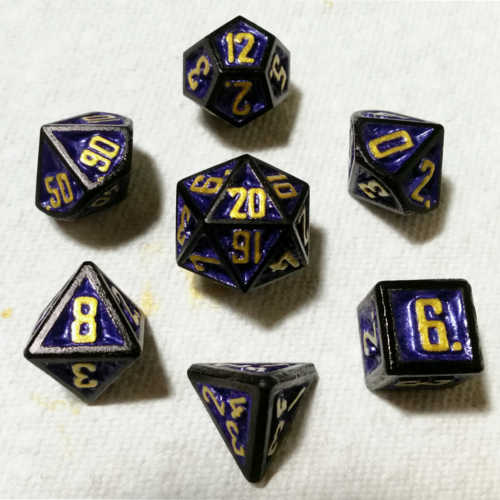
D&D Dice Set with Outset Numbering (d4 to d20)
pinshape
A Custom D&D Dice Set for Painting These dice feature distinctive numbering and edges, with the remainder of the face inset. This allows for up to three colors to be applied simultaneously once printed. The dice set comprises a d20, d12, d10, d00, d8, d6, and d4. Painting Example: To achieve the purple/gold/black dice's striking appearance, I started by sanding the dice to a finish that ensured they registered as fair when I roll-tested them. Using a χ2 test helped me gauge their fairness. Next, I mixed purple acrylic paint with varnish and filled in the depressed areas. Once dry, I sanded the dice again, leaving only the purple paint in the recessed areas. Then, I colored the edges using a sharpie. Finally, I painted the numbers with a small brush, using gold paint mixed with varnish. Fairness: It's possible to subtly bias the dice during sanding by sanding the opposite face broader than the rest. To ensure fairness, I found that seeing-saw between sanding the largest and smallest numbers (e.g., 1, 20; 2, 19) yields the best results. Dice Numbering: I gave considerable thought to the dice numbering system. For the d20, I employed an ideal numerically balanced system described in this paper: www2.oberlin.edu/math/faculty/bosch/nbd.pdf Base Forms: The models were inspired by Platonic solids and came from Dan Hienzsch via hackaday.io/project/161211-parametric-platonic-solids-from-fusion-360. The pentagonal trapezohedron (d10, d%) was modified to be fully solid and originated from Zdolshin via thingiverse.com/thing:3321836. Printing: The models are oriented with one edge resting on the build platform. While this necessitates supports, it seems to provide higher quality and more uniform prints. The purple/gold/black, yellow, and blue die sets were printed on their edge. In contrast, the faux metal, green/silver/blue, and red die sets were printed flat on a face. The multicolor set and lone d20 were test prints. Printing Details: PLA was used for all prints, created using a LulzBot TAZ 6 with various layer heights and settings. Layer Height: I encountered quality issues on overhangs when using heights other than the printer's default high-detail height. Infill: The gyroid infill @ 99.999% worked well for me. In theory, its uniform strength from all angles helps ensure fair rolls. Supports: Zig-zag supports @ 30% density proved effective for me. Shell: A thick shell (~3/4 layers) is recommended to facilitate easy cleaning of the dice.
With this file you will be able to print D&D Dice Set with Outset Numbering (d4 to d20) with your 3D printer. Click on the button and save the file on your computer to work, edit or customize your design. You can also find more 3D designs for printers on D&D Dice Set with Outset Numbering (d4 to d20).
